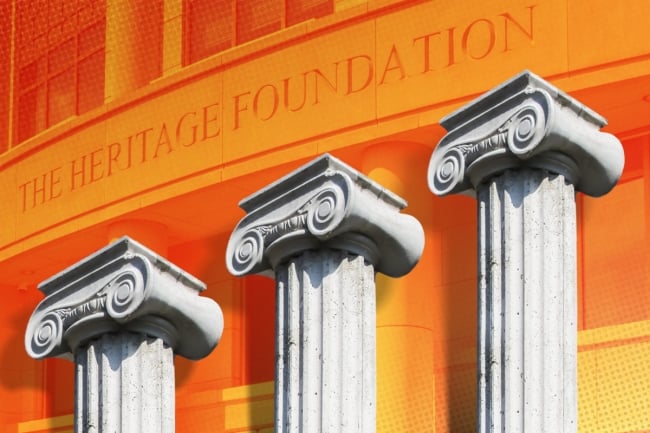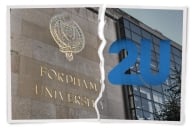You have /5 articles left.
Sign up for a free account or log in.

The Heritage Foundation’s new college and university ratings take into account students’ earnings after graduation rates and the prevalence of diversity, equity and inclusion administrators per 100 faculty members.
Photo illustration by Justin Morrison/Inside Higher Ed | Andrew Harnik/Getty Images | rawpixel
U.S. News & World Report. The Wall Street Journal. Campus Pride. From exclusivity to return on investment to LGBTQ+ friendliness, organizations judge, rank, rate and label U.S. colleges and universities in multitudinous ways.
Now, there’s a new kid on the ratings block: The Heritage Foundation has launched a “Choose College With Confidence” guide, which labels 280 institutions as either red, yellow or green. Those given a green light are considered a great option for families “prioritizing freedom, opportunity and civil society,” while red-flagged colleges are not recommended. According to the guide, they “exhibit a pervasive hostility toward diverse viewpoints and lack robust core curricular requirements.”
Harvard University got a red light, for example. New College of Florida, Auburn University and West Virginia’s Appalachian Bible College were among those that received greens.
The guide from Heritage, a conservative think tank, comes as colleges and universities face increased scrutiny from conservative groups and lawmakers questioning their academic offerings and funding decisions and raising concerns about how welcoming they are to students with conservative views.
Madison Marino, a senior research associate at Heritage’s Center for Education Policy, said at an online news conference Thursday that the guide was designed for families and students to get “comprehensive information about higher education and be able to empower these families and students to make informed choices about where they want to go.”
Lindsey Burke, director of the Center for Education Policy, acknowledged that it’s a “pretty crowded space” for college guides, “but what’s unique about ours is that we do take into account more than just your ROI.” She said that includes the question “Is this a university, an institution, that is welcoming to all viewpoints, including conservatives’, who have been incredibly marginalized in academia for dozens upon dozens of years?”
In the guide, she said a “red light” means, “Effectively, do not send your kids to these schools.” Burke is also a board member at George Mason University, which was rated yellow.
Heritage, a vocal critic of college diversity, equity and inclusion programs, spearheaded Project 2025, a controversial blueprint for Donald Trump’s potential second presidential term. That plan calls for eliminating the Education Department, among other changes. Burke wrote the chapter on the Education Department.
To sort the colleges into the three categories, Heritage researchers said they took into account four-year graduation rates and students’ postgraduation incomes—statistics one might expect in college and university comparisons. But their listed metrics also include the prevalence of diversity, equity and inclusion administrators; the number of “conservative” compared to “liberal” clubs; and whether institutions have bias reporting systems, require diversity statements in hiring or house departments of ethnic or gender studies.
Heritage dinged institutions in the ratings if they had those departments, said Jonathan Butcher, a senior fellow at Heritage and at the conservative Goldwater Institute who helped compile data for the report.
“We believe that ethnic studies is based on a Marxist view of the world as being determined by power struggles,” Butcher said, and that it’s part of the “identity politics” that gender studies departments also perpetuate.
But it’s unclear how much emphasis the creators of the new guide put on any individual metric when rating institutions, nor does the guide show which institutions received demerits in which specific categories. Butcher said, “We did not weight any of the categories” and considered the findings more on the “qualitative side.”
“We needed to begin with something that sent a message,” Butcher said. Referencing existing college and university ratings and rankings, he said Heritage “wanted to add something to this library, this research, of how to evaluate colleges and give parents something they may not be able to find somewhere else.”
The first sentence of the methodology seems to suggest it’s a guide for conservatives to identify conservative colleges: “Heritage researchers began by surveying state policy affiliates to get a sense from partners on the ground about which colleges and universities are good options for conservatives.” Those affiliates are state-level think tanks that are themselves affiliated with the conservative State Policy Network.
When asked if the labels were mostly based on which institutions were best for conservative students, Butcher said, “The effort is to preserve not just free expression but quality in general.”
For decades, conservatives have sounded the alarm about what they see as the hostile environment at many American colleges for conservative students and professors. Disruptive pro-Palestinian protests on some campuses this past academic year supercharged those concerns.
Still, Butcher said, there was no particular reason the ratings came out now, though researchers partly chose which institutions to rate based on which had been in the news for controversial protest encampments.
Rating This Rating
Some critics of rankings and the Heritage Foundation gave the organization’s foray low marks.
Akil Bello, senior director of advocacy and advancement at FairTest, which advocates against standardized tests, told Inside Higher Ed, “All rankings are some form of personal opinion filtered through mathematics, so it’s a subjective assessment of quality. The only difference in the various rankings is how subjective are they, whose point of view is it reflecting and how transparent are they about their biases.”
Bello said Heritage’s ratings reflect the organization’s “aggressively right-wing” viewpoint. He also noted that Heritage’s methodology took into account information from other conservative organizations.
“There’s no better way to get the rankings you want than to start with the people who agree with you,” Bello said. “If the factors you evaluate can only be verified by like-minded individuals, it is not an objective ranking.”
Isaac Kamola, director of the American Association of University Professors’ Center for the Defense of Academic Freedom and an associate political science professor at Connecticut’s Trinity College, called the methodology “purely ideologically driven, again, by market fundamentalists.”
Kamola noted that Heritage announced the new college ratings alongside a K-12 scorecard that promotes school choice.
“Delegitimizing higher education, it goes hand in hand with this broader project of defunding K-12 education, and you don’t get a clearer example of that” than the simultaneous release, Kamola said.
However, Preston Cooper, a senior fellow at the conservative American Enterprise Institute who studies higher education, said he thinks the new ratings are “a useful service to have” for people with conservative values and interests.
“I think it makes total sense that we can have different ranking systems to prioritize different things when it comes to college,” he said.








